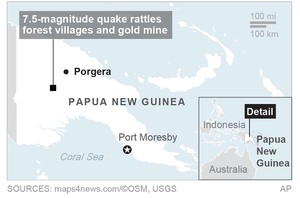© Turkuvaz Haberleşme ve Yayıncılık 2024
More than 30 people are believed to have died after a powerful earthquake struck Papua New Guinea's mountainous interior, a report said Tuesday as details of "extensive" damage began to emerge.
An earthquake of magnitude 7.5 struck the island nation early Monday, the U.S. Geological Survey said, followed by two strong aftershocks of 6.0 and 6.3 magnitudes rattling the rugged region.
The quake hit a central region of the country's main island of New Guinea at a depth of 35 kilometers, 90 kilometers (55 miles) south of Porgera in the Enga province.
Phone lines were largely cut, but the PNG Post Courier newspaper cited Hela provincial administrator William Bando as saying there were casualties.
It reported that at least 13 died in the Southern Highlands capital Mendi while 18 others were believed to have been killed in nearby Kutubu and Bosave.
Some 300 people were injured, it added, and properties damaged, with reports of landslides and sinkholes.
The Papua New Guinea Today website, quoting Catholic priest Pius Hal, said at least 10 died, including four children, in quake-triggered landslides.
 A government assessment team was due to fly into the area Tuesday to get a better idea of the impact, with the military mobilized to help restore services and infrastructure, the government's Chief Secretary Isaac Lupari said in a statement.
A government assessment team was due to fly into the area Tuesday to get a better idea of the impact, with the military mobilized to help restore services and infrastructure, the government's Chief Secretary Isaac Lupari said in a statement.
"Information will be provided as this is made available from assessment teams in the area," he added.
Hela governor Philip Undialu, who was in the capital Port Moresby, told The National newspaper there was widespread damage.
"The scale of damage, from information we are getting from the ground, is quite extensive," he said, adding that there were around 19 landslides between Mendi and the town of Mount Hagen.
"Our police station, courthouse, hospital ... even private houses have been ripped apart or sunk into the ground.
"It's going to be a massive recovery exercise."
The quake hit the site of a large gold mine that employs more than 2,500 residents. The area also is home to a number of oil and gas operations and coffee plantations.
ExxonMobil Papua New Guinea said Monday it had shut down the Hides Gas Conditioning Plant, where there was damage to the administration buildings, living quarters and mess hall.
Oil Search Managing Director Peter Botten said the company was closing down some production operations in the region as a precaution.
Both Oil Search and ExxonMobil said there were no reports of any injuries to their staff, and ExxonMobil said its staff was accounted for and safe.
The area lies along an earthquake zone known as the Papuan Fold Belt, which is the fault responsible for the mountain range that forms the spine of the nation. A series of strong aftershocks had rattled other parts of the fault line.
Papua New Guinea is located on the eastern half of the island of New Guinea, to the east of Indonesia. It is home to about 7 million people.
